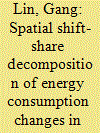| Srl | Item |
| 1 |
ID:
130975


|
|
|
|
|
| Publication |
2014.
|
| Summary/Abstract |
The present paper investigates how neighborhood effects are connected to chronic poverty. We examine a large sample of groups of households and find that neighborhood effects are significant in a majority of groups, especially in the poorest groups. People living in poor communities tend to suffer from poverty over time. It is of theoretical and empirical importance to explore how neighborhood effects are interrelated with chronic poverty and the channels through which this occurs. Unlike other econometric analyses, we establish a multilevel econometric model to show that: (i) it is difficult for an individual living in a neighborhood with a high proportion of agricultural labor, low education levels, and poor transport and telecommunication infrastructure to escape from poverty traps; (ii) neighborhood effects dominate in poor communities; and (iii) although poverty is affected by group-level factors, individual factors still play a dominant role in regards to escaping poverty when income surpasses a threshold level. Therefore, policy priority should be given to providing social protection and public services, especially in poor rural areas
|
|
|
|
|
|
|
|
|
|
|
|
|
|
|
|
| 2 |
ID:
169884


|
|
|
|
|
| Summary/Abstract |
The objective of this paper is to investigate the changes in the regional energy consumption at the provincial level in China from 2007 to 2016 by introducing a spatial shift-share decomposition approach to measure the neighborhood effect on the regional energy efficiency change through the establishment of a spatial weight matrix considering the geographical and economic proximity. Using this decomposition method, the regional advantage (or disadvantage) in energy efficiency can be revealed, excluding the influence of neighborhood performance in terms of energy efficiency. The results indicate that a shift from energy intensive industrial productions toward the less energy intensive service sector occurs in almost all provinces of China over the period observed; there is significant spatial differentiation on the spatial decomposition of the efficiency change component across provinces, and the changes in energy efficiency in provinces of Jing-Jin-Ji, Yangtze River Delta, Chengdu-Chongqing, Guanzhong Plain, Pan-Pearl River Delta city agglomeration and the three provinces in Northeast China are mainly affected by the neighborhood effect. Our empirical findings suggest that energy policy making should be more concerned about the spatial correlation and coupling effects of energy consumption, especially in the national urban agglomeration of China.
|
|
|
|
|
|
|
|
|
|
|
|
|
|
|
|